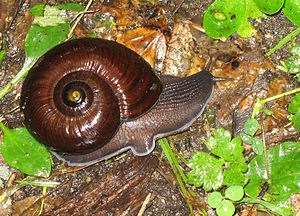Powelliphanta annectens
| Powelliphanta annectens | ||||||||||||
|---|---|---|---|---|---|---|---|---|---|---|---|---|

Powelliphanta annectens , at Heaphy Hut, Heaphy Track , Kahurangi National Park , 2007 |
||||||||||||
| Systematics | ||||||||||||
|
||||||||||||
| Scientific name | ||||||||||||
| Powelliphanta annectens | ||||||||||||
| ( Powell , 1936) |
Powelliphanta annectens is the name of a predatory living snail from the family Rhytididae in the subordination of terrestrial snails (gastropod), which in a small area on the South Island of New Zealand native.
features
The snail shell of Powelliphanta annectens is almost as big as that of Powelliphanta hochstetteri and also resembles it in shape. The surface of the case is smooth, apart from numerous axial growth stripes and weak, irregular spiral lines in the first turns. The parietal callus and the inside of the case mouth are coated with fine grains. The house of the adult snail has five and a half slowly increasing coils, of which the small, almost completely flat, shiny protoconch comprises one and a half whorls. The dome-shaped thread protrudes about 5 mm over the body circumference. The seam is deeply indented and slightly bent towards the mouth of the case. The umbilicus takes up about a fifth of the large diameter of the base. The thin, non-continuous edge of the case mouth protrudes upwards and is slightly bent downwards. The basic color of the house is reddish brown and becomes a little pale at the top towards yellow-brown-olive. The entire surface is radially striped with narrow red-brown, sepia-colored and black bands, the protoconch is anal-yellow and the parietal callus is lighter-grained caramel brown, the inside of the case mouth is slate-brown. The diameters of the house are 63.6 mm to 73 mm and 53.5 mm to 62 mm, the height 34 mm to 40.5 mm.
Distribution and occurrence
Powelliphanta annectens is endemic to the north of the South Island of New Zealand , where it was found at an altitude of around 600 m to 800 m between the Oparara River at Karamea and Gunner Downs south of the Heaphy River . The highest population densities are found in forests with Nothofagus menziesii and Metrosideros spp.
Life cycle
Like other species of the genus Powelliphanta , Powelliphanta annectens is long-lived and, after the hermaphrodites have fertilized each other, lays only a few oval eggs per year, which are about 9 mm long and 8 mm wide.
nutrition
The main food of Powelliphanta snails are earthworms .
Predators and threats
Like other Powelliphanta species, Powelliphanta annectens is particularly threatened by imported predatory mammals . The most important role here is played by the imported climbing bag Trichosurus vulpecula and rats ( Rattus spp.).
Web links
Individual evidence
- ^ Arthur William Baden Powell , 1936: The Paryphantidae of New Zealand. III. Further New Species of Paryphanta and Wainuia. Records of the Auckland Institute and Museum 2 (1), pp. 29-41, here pp. 30f.
- ↑ a b Kath Walker, in: Carl A. McGuinness: The Conservation Requirements of New Zealand's Nationally Threatened Invertebrates. Carnivorous land snails - Powelliphanta ( Memento from October 21, 2012 in the Internet Archive ). Threatened Species Occasional Publication No. 20, NZ Department of Conservation, Wellington 2001. p. 127.
- ^ AC O'Connor (1945): Notes on the Eggs of New Zealand Paryphantidae, With Description of a New Subgenus. Transactions of the Royal Society of New Zealand 5 (1945-1946), p 54 -57.
- ↑ New Zealand snails: Powelliphanta Department of Conservation / Te Papa Atawhai, Christchurch of 2006.